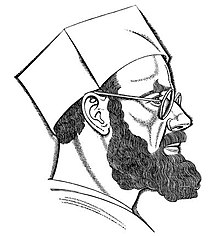Eric Gill
| Eric Gill | |
|---|---|

Self portrait
|
|
| Born |
Arthur Eric Rowton Gill 22 February 1882 Steyning, Sussex, England |
| Died | 17 November 1940 (aged 58) Middlesex, England |
| Known for | Sculpture, typography |
| Movement | Arts and Crafts movement |
Arthur Eric Rowton Gill ARA (/ˈɡɪl/; 22 February 1882 – 17 November 1940) was an English sculptor, typeface designer, stonecutter and printmaker, who was associated with the Arts and Crafts movement. He is a controversial figure, with his well-known religious views and subject matter generally viewed as being at odds with his sexual behaviour, including his erotic art.
Gill was named Royal Designer for Industry, the highest British award for designers, by the Royal Society of Arts. He also became a founder-member of the newly established Faculty of Royal Designers for Industry.
Gill was born in 1882 in Hamilton Road, Brighton and grew up in the Brighton suburb of Preston Park. One of twelve children, he was the elder brother of MacDonald "Max" Gill (1884–1947), the graphic artist. In 1897 the family moved to Chichester. He studied at Chichester Technical and Art School, and in 1900 moved to London to train as an architect with the practice of W.D. Caroe, specialists in ecclesiastical architecture. Frustrated with his training, he took evening classes in stonemasonry at Westminster Technical Institute and in calligraphy at the Central School of Arts and Crafts, where Edward Johnston, creator of the London Underground typeface, became a strong influence. In 1903 he gave up his architectural training to become a calligrapher, letter-cutter, and monumental mason.
...
Wikipedia
